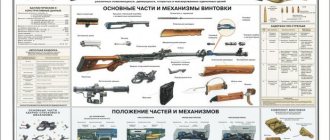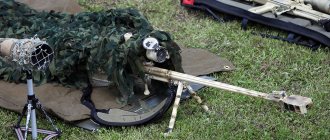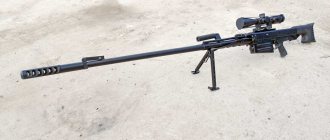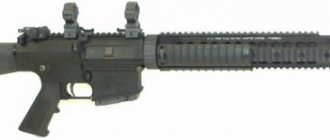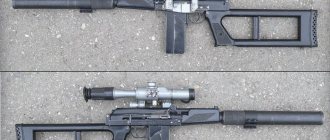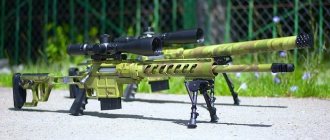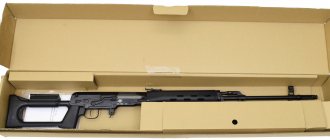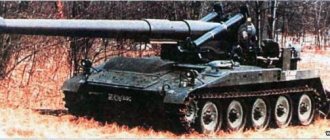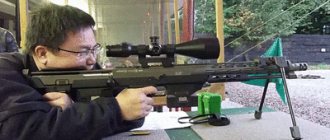Home | Weapons | Sniper rifles | Russia / USSR | SVU / SVU-AS
Sniper rifle SVU (Sniper Rifle Short) Photo (c) KardeN
Shortened sniper rifle SVU-AS Photo (c) KardeN
The shortened sniper rifle SVU OTs-03 was created by TsKIBSOO in Tula. In essence, the SVU is a deep modernization of the well-known and well-proven Dragunov army sniper rifle by Izhevsk designer E.F. Dragunov. The development of a shortened version of the SVD sniper rifle for arming the USSR Airborne Forces began back in the seventies of the twentieth century. Back in 1975, TsKIB designer L.V. Bondarev proposed redesigning the rifle according to the bullpup design.
In 1979, tested samples of the rifle, called SVU or OTs-03 (“TsKIB model three”), were demonstrated in airborne units, but at that time the military showed no interest in it, believing that the standard SVD fully met their needs. Serial production of shortened SVU sniper rifles was launched only in 1991 at the insistence of the Vympel special forces command. The SVU rifle (OTs-03) was proposed by the Russian Ministry of Internal Affairs as a weapon for combat operations in urban environments, where the increased maneuverability of a short rifle is an absolute advantage.
The shortened SVU sniper rifle uses basic mechanisms and a modified receiver from the SVD sniper rifle. The SVU retains a gas venting mechanism with a regulator and a short stroke of the gas piston, as well as locking by turning the bolt from the SVD. The changes affected the trigger mechanism, which received a long rod connecting it to the trigger placed forward.
Since the serial SVD rifle was taken as the basis, it was a question of replacing the frame stock with a butt plate, a shoulder rest and a pistol grip, changing the trigger mechanism, mounting the sight, and solving issues of balancing the weapon. “Linear recoil” with a high power rifle cartridge required special devices to compensate for the high recoil energy. During the development process, it was also discovered that it was possible to shorten the barrel somewhat without compromising accuracy. The barrel was shortened by 100 mm, and the gas chamber was moved back. Increased loads on the gas piston rod required special measures to prevent its breakage - this problem was solved by a hinged earring on the rod, resting against the wall of the gas outlet tube. The trigger is connected to the trigger mechanism by a trigger rod mounted along the left wall of the receiver.
To reduce the impact of recoil on the shooter, an elastic butt plate - a shoulder rest - and a three-chamber muzzle device are used. The butt pad is not rigidly attached to the receiver, is equipped with a leaf spring and can be slightly rotated forward, absorbing part of the recoil energy. The muzzle device is complex and simultaneously plays the role of a muzzle brake, absorbing up to 40% of the recoil energy, a compensator weight that reduces barrel vibrations and shifts the center of gravity of the weapon forward, and a flame arrester. In addition, due to the expansion and cooling of gases inside the chambers, the device also reduces the sound level of a shot to 150 dB.
The plastic pistol grip is located near the center of gravity of the weapon and has a comfortable ergonomic shape. A slightly enlarged trigger guard allows you to fire while wearing gloves. A non-adjustable “cheek” is mounted on the receiver cover, which provides support for the shooter’s head when aiming. The plastic handguard linings and their mounts are taken from the SVD, but a cutout is made in the left lining due to the forward displacement of the sight mount.
The PSO-1 (1P43) optical sight is attached to the SVU rifle. The sight mount has been moved slightly forward and upward. It is possible to install night sights of the NSPU type and a laser target designator. The SVD sector open sight has been replaced by a diopter sight, made like a hunting weapon: an adjustable diopter and a front sight with a fence are mounted on folding stands. The barrel of the diopter sight has settings up to 1300 m - more than such a weapon can provide. Shooting with a diopter sight is possible both with the optical sight removed and installed. The elevation of the diopter sight above the butt does not force the shooter to tilt his head excessively.
The weapon is powered from a standard SVD magazine with 10 rounds. There is no attachment for a bayonet-knife. The butt plate, receiver, pistol grip and forend are usually covered with camouflage paint. There are swivels for the belt. For shooting, regular or sniper rifle cartridges are used. Later, in 1993, at the request of the Ministry of Internal Affairs in the city of Tula, the OTs-03A version (SVU-A after adoption) was developed and adopted, which was distinguished by the ability to conduct automatic fire.
In 1995, at the suggestion of military personnel who operated the shortened SVU sniper rifle in Chechnya, the SVU-AS (OTs-03AS) variant was developed and adopted for service, differing from the SVU-A by the presence of a folding bipod mounted under the barrel on a special bracket. For shooting while standing with an emphasis on a wall or tree, the bipod is made to rotate sideways. In the SVU-A and SVU-AS rifles, the trigger mechanism is modified to provide automatic fire. The choice of fire mode is carried out by the degree of pressure on the trigger - a short press causes single shots, a long press (all the way) causes automatic fire.
Automation, the locking system, the design of the bolt frame, the bolt, the assembly of parts of the trigger mechanism, and the receiver have not undergone any changes. The continuous shooting mode is implemented by increasing the length of the trigger stroke. In this case, when cocked, the hammer does not disconnect the sear from the trigger rod, and the next shot is fired with a self-timer after the bolt comes to the forward position and the barrel bore is locked. Since the rifle is designed according to the bullpup design, the trigger pull is made longer than that of the SVD. The design of SVU-A and SVU-AS includes a special translator located within the trigger guard and limiting the movement of the trigger. This made it possible to introduce a second fire mode without noticeable changes to the trigger mechanism.
The buttstock, whose functions are performed by the rear part of the receiver, is equipped with a spring-loaded butt plate. The handguard, butt and cheek piece are made of polyamide. The bipod required significant additions. To install them, a special horizontal rod is used, rigidly fixed in front of the receiver. The hinged mount of the bipod and the angle of spread allow them to be rotated relative to the weapon. The bipod can rotate around its axis 90 degrees to the right or left. The bipod itself is telescopic, with four fixed height settings (maximum height 320 mm).
Magazines for 20 and 30 rounds have also been developed. However, when firing in bursts with such magazines, powder gases will accumulate in the chambers of the muzzle device, and its effectiveness may be significantly reduced. Instead of a sector sight, a diopter sight is installed. The rear sight and front sight are adjustable and mounted on folding stands. The range of ammunition for the OTs-03A and OTs-03AS is the same as for the SVD, but it is still advisable to use special sniper ammunition that provides the best accuracy of fire.
Outside of combat, the IED is carried on the back in a closed canvas case with pockets for accessories and spare magazines. From the point of view of shooting accuracy with single shots, according to available data at short and medium ranges, the SVU series rifles are approximately similar in characteristics to the Dragunov SVD rifle. The main customers of the shortened IED sniper rifle series were the Russian structures of the Ministry of Internal Affairs and the FSB.
Owner reviews
“Dimensions and accuracy are better than those of the SVD. My SVU-AS has a factory shooting range of 2.5 cm at 100 m, LPS, 4 shots. When shooting, you can stand nearby and the recoil is not strong, unlike the SVD. Weight is 5.5 kg, but it doesn’t feel heavy. Due to the fact that the trigger rod is a long thin plate and is hidden under a high, poorly secured cover, when the trigger is pressed it bends and rests against the cover. And then it transfers the force to the trigger. Therefore, the descent is long and unpredictable. When shooting, especially from a bipod, the power of the compensator is such that it blows the rifle several centimeters to the side, and the target is lost from view. Without optics, with a mechanical sight, a very accurate, convenient, FG42 type, especially since the sight and front sight were copied from it and a front sight cover was added to protect it from impacts. It’s strange that no one mentions this anywhere.”
KardeN is an employee of a special unit of the Ministry of Internal Affairs who has extensive combat experience in “hot spots”
Sniper rifle SVU-AS (OTs-03AS). Why is it called an “urban combat rifle”?
Sniper rifle, short, automatic, bipod mounted. This is exactly how the “civilian” name SVU-AS stands for this interesting domestic weapon. OTs-03 is the name of the rifle given to it by TsKIB.
The development of the rifle was started on an initiative basis in 1975 (according to other sources - in 1977) by the leading designer of the Tula TsKIB SOO L. V. Bondarev. The reason is that the Dragunov army sniper rifle is too long, which, due to this shortcoming, cannot be used in airborne operations. Weapons of this length are dumped in bales that may not be found later. So, the main criterion was the maximum reduction in the length of the rifle without a strong deterioration in the tactical and technical characteristics compared to the SVD rifle.
What was done?
The design of the new rifle made maximum use of the parts and components of the SVD rifle: automatic gas release, barrel bore locking system, bolt frame device, bolt, almost the entire trigger mechanism, receiver, 10-round magazine, 7.62×54 R cartridge.
A bullpup layout was used, in which the magazine with ammunition is located behind the fire control handle, one might say, in the butt.
The SVD barrel was shortened by 10 cm.
Fire control is carried out using a comfortable pistol grip. The handle is in the middle, which has a positive effect on balancing the weapon.
The stock has been replaced with a spring-loaded shoulder rest, which reduces recoil.
The trigger mechanism is connected by a long rod to the firing mechanism.
The sights consisted of a folding dryopt and a front sight in a ring frame, similar in design to those on the German FG-42 automatic rifle.
The method of attaching the optical sight has been changed.
The gas mechanism was moved closer to the receiver and modernized. Now the gases from the barrel were moved not by the gas piston itself, but by a special earring, which reduced the pressure on the gas piston to the “standard ESW.”
Added muzzle brake compensator.
What did all these innovations give?
The weapon turned out to be so compact that a paratrooper could jump with it; moreover, the tilt of the pistol grip made it quite comfortable to fire at ground targets while in the air.
The weapon was first tested in the Tula Airborne Division. The only wish was to reduce the sound of the shot. After this, instead of a simple muzzle brake, a three-section muzzle brake-compensator was developed, which, in addition to significantly “choking” the sound of a shot, also reduces recoil by about 40%, reduces vibration and barrel bounce when firing, and eliminates muzzle flash.
After this, the rifle was handed over to the military and... They noticed only shortcomings in it, without paying attention to the advantages. The following were noted: loss of accuracy, excessive complexity and faster wear of mechanisms compared to the SVD rifle.
The rifle did not go into mass production. How can one not see the analogy with the FG-42 automatic rifle, which at first they also wanted to put into service, and then only the personal intervention of the Reich Minister of the Imperial German Aviation Ministry Hermann Goering helped correct the situation.
This happened with the SVU rifle. Until the early 90s of the 20th century, no one remembered about it. The first production batch of rifles was produced from standard army SVD only in 1991, at the insistence of the command of the Vympel special forces detachment.
The first modernization was carried out in 1993. The weapon received an automatic fire mode and became known as SVU-A (OTs-03A). The selection of the fire mode is carried out by pressing the trigger - a short press would cause a single shot, and pressing all the way would cause automatic fire. To conduct only automatic fire there is a special switch flag. In the manual, by the way, this fire mode is recommended only for emergency cases: the accuracy is significantly reduced, the sound is not muffled, the barrel overheats, plus there is very strong wear and tear on the mechanisms. Well, what kind of machine gun with a 10-round magazine? True, 20- and 30-round magazines were later developed.
And then there was the Chechen war. An excellent testing ground for all types of small arms. SVU passed it with honor. The only request of the veterans of the war in Chechnya was to add a lightweight folding bipod to the weapon. Well, how can we not remember the German FG-42 again! A bipod was added, and not a simple one, but with four height locks and rotatable by 90 degrees, for support on both horizontal and vertical surfaces. The bipod is attached directly to the receiver. The modification with such a bipod was called SVU-AS (OTs-03AS).
Technical characteristics (SVU-AS):
Weight, kg: 5.6 (with a POSP8×42 optical sight and a magazine without cartridges), 6.1 (with a DS5 day/night vision sighting system and a magazine without cartridges). Length, mm: 980. Barrel length, mm: 520. Cartridge: 7.62×54 mm R. Caliber, mm: 7.62. Rate of fire, rounds/min: 30 (combat), 650 (technical, SVU-A and SVU-AS). Effective range, m: 800. Maximum aimed firing range, m: 1300.
Source: Wikipedia.
And finally... When I was collecting information on this rifle, I found a description of an interesting competition. 20 shots were fired from an IED and an army SVD. The shooting was carried out while standing. The IED shooter hit all the targets without wearing headphones or wearing a shirt. No discomfort or bruise on the shoulder. The shooter with the SVD put on his headphones after the second shot and after a few more shots he lay down, since it was uncomfortable to shoot from the shoulder, and got a rather large bruise. This is the difference in “shooting comfort”.
Tags: rifle, history of weapons, shooting, weapons, technology, inventions
Technical characteristics of the shortened sniper rifle SVU-AS
- Caliber: 7.62×54R
- Weapon length: 900 mm
- Barrel length: 520 mm
- Weapon height: 229 mm
- Weight without cartridges: 4.4 kg.
- Rate of fire: 650 rounds/min (for SVU-AS)
- Magazine capacity: 10 rounds
Sniper rifles
- Austria
- Hungary
- Brazil
- Czech
- South Africa
- France
- USA
- Russia/USSR
- Finland
- Uruguay
- Israel
- Germany
- Türkiye
- Switzerland
- South Korea
- Japan
- Belgium
- Poland
- Ukraine
- Croatia
- Serbia
- China
- Canada
- Great Britain
Well MB 12D
Despite the fact that this air rifle is made according to the VCA form factor, it has practically nothing in common with it.
- The principle of shooting is spring , that is, after each shot it is necessary to manually jerk the bolt, which tightens the spring to fire the next shot.
- Installation of a sight of type PSO-01 is allowed.
- The initial speed of the bullet is 80 meters per second (although if you remove the special plug installed in the nose, the speed will increase to 120 meters per second).
- The sighting range is about 80-100 meters.
- The magazine capacity is only 28 rounds, but loading is fast.
- Caliber - 6 millimeters.
- Of course, the Svu sniper rifle is much better in its characteristics, but it is important to note the fact that the Well MB 12D costs only 9-12 thousand rubles.
- The hop-up here is adjustable, so for true connoisseurs of sniper weapons, additional opportunities for fine tuning also open up.
- The length of the rifle in “combat” condition is 1200 millimeters
- Weight - only 4 kilograms.
- The inner barrel has a length of 500 millimeters (the width of the internal opening is 6.08 millimeters).
Well MB 12D
The disadvantages of the model include:
- many plastic parts of the case, which are easily damaged;
- the spring that moves the cylinder quickly fails, so it is recommended to immediately replace it with a more durable metal model. These are sold in almost every gun store (it is better to choose a product with a thickness of 2.2 -2.5 millimeters, with a number of turns up to 60).
Most pneumatic buyers are interested in its reliability, and in this regard, it is worth reading material about the most reliable air rifle.
Read the material about the characteristics of the Anzio sniper rifle here.
See prices for Edgan Matador air rifles at:
Well MB 12D is an excellent choice for beginners who are just learning the basics of the airsoft game and are not yet ready to spend a large sum on weapons. Moreover, it is easy to find replacement components for this rifle, so there are no difficulties in terms of repair and maintenance.
In this video you will be shown a review of the Well MB 12D rifle.
IZH-61
The IZH-61 rifle does not belong to the custom shortened Dragunov sniper rifles, but despite this, it is in great demand among Russian airsoft players. Its technical features are as follows:
- initial bullet speed - up to 130 meters per second;
- caliber - 4.5 millimeters (lead or steel bullets);
- weight - 2.1 kilograms (fully equipped with a scope);
- release type - mechanical (reloading is performed with a side lever);
- the barrel is fully rifled (length 470 millimeters).
- effective firing range is 60-80 meters.
SVU rifle, short with silencer, for airsoft (airsoft weapon)
The SVU rifle is one of the most famous modifications of the SVD (Dragunov sniper rifle) of the shortened type. Introduced into service with the Russian army, it is used for targeted shooting during assault operations (in open areas).
The main advantage of the model is its lightness and compactness, a fairly spacious mechanism and excellent aimed shooting performance. It is not surprising that airsoft widely uses its pneumatic variation, designed to fire lead bullets of 4.5 - 6 mm caliber.
One of the most popular models of pneumatic IEDs is rightfully considered the SVU-AS (Russian-made, NPO AEG concern), as well as the Well MB 12D, which only partially resembles an IED in appearance, but allows targeted shooting in a prone position (a stand is included in the kit ).
SVU-AS
SVU-AS is one of the most reliable sniper air rifles , but this also affects its cost - about 32 thousand rubles.
- Designed to use 4.5 mm bullets. Their initial flight speed is 140 meters per second.
- Firing range is about 150 meters.
- The trigger mechanism is electric, the batteries are installed in the butt and are designed to fire 250 shots (this is the maximum capacity of the hopper).
- The batteries are replaceable, so this type of rifle is an ideal option for airsoft games.
- The weight of SVU-AS is 4.5 kilograms, since all its mechanisms and elements are made of high-quality steel, as well as aluminum alloys).
- The permissible weight of the balls is 0.2 grams. The use of heavier variations is allowed, but this wears out the barrel much faster.
The rifle is equipped with a manual safety lock, as well as a lever for switching the firing mode (single or burst), thanks to which it can be used to conduct targeted assault fire. The SVU AS rifle is very reliable. Models from foreign manufacturers are often inferior to it in terms of quality.
Does SVU AS have any disadvantages ? There are only a few of them:
- play in the stock where the batteries are installed, which often causes a broken contact (easily corrected by installing a gasket or more capacious batteries);
- relatively heavy weight. Many SVD air rifles from foreign manufacturers have almost 1.5 times larger dimensions, but weigh only 3-4 kilograms.
Scope mount - dovetail . Moreover, experienced players recommend equipping a sniper rifle with a scope of the PSO-01 class, which will allow targeted fire at a distance of up to 250 meters (subject to correct calibration). If you have never shot from a rifle, then the material on how to learn to shoot from a sniper rifle will help you with this. It will also be possible to familiarize yourself with the rules for shooting with an air rifle at the address.
Air rifles SVU and SVU-A from SVU-AS are distinguished by the presence of a mount for a sight, as well as mounts for installing a “tee”. Such models are produced in China, Taiwan, and Russia. See prices for Chinese air rifles here, you can also see prices for SVD air rifles.
For the SVU-AS rifle, larger bunker magazines are available, designed for 300-400 bullets, but they are rarely used, since the operation of the rifle in this case becomes inconvenient, especially for assault games.
